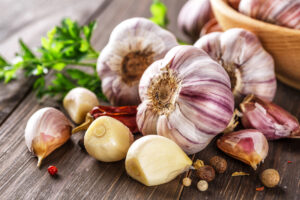Introduction
Ready to jazz up your culinary creations? Try learning how to ferment garlic at home! It’s easy. Just peel the garlic, add it to a jar, pour in a saltwater brine, and let it sit for a few weeks. The result? Tangy, nutritious, and long-lasting garlic that enhances any dish.

Preparation:
Select Fresh Bulbs
To start the fermentation process, it’s crucial to select high-quality, fresh garlic bulbs. Look for bulbs that are firm to the touch with tight, unbroken skin. Once you’ve chosen your garlic, the next step involves peeling the cloves. Be gentle to avoid damaging the cloves as their integrity is important for successful fermentation.
Clean and Sterilize Jars
After preparing your garlic, the next step is to ensure your fermentation jar is clean and sterilized. Any impurities or existing microorganisms in the jar can negatively affect the fermentation process, leading to an unwanted outcome. To sterilize your jar, wash it thoroughly with soap and warm water, and then place it in a pot of boiling water for 10 minutes. Once this is done, carefully remove the jar without touching the inside, and let it air-dry. This ensures a clean environment for your garlic to ferment successfully.
Setting up the Fermentation Process
Placing the Garlic and Adding the Brine:
Begin by placing your peeled garlic cloves into the sterilized jar, arranging them as compactly as possible. The closer together the cloves are, the less chance there is of them floating to the surface. Once your cloves are in place, it’s time to prepare your brine solution. For a basic brine, dissolve 1-3 tablespoons of sea salt in a quart of water. This can be adjusted according to taste, but remember that too much salt can inhibit the fermentation process and too little can result in spoilage.
Once your brine is ready, slowly pour it into the jar, completely covering the garlic cloves. It’s vital to ensure that the cloves stay submerged throughout the fermentation process, as exposure to air can lead to spoilage. To achieve this, you can use a fermentation weight, or a smaller jar filled with water to keep the cloves under the brine.
Fermentation
Covering the Jar and Waiting:
After ensuring the garlic cloves are fully submerged in the brine, the next step is to cover the jar to protect the fermenting garlic from unwanted external elements while allowing gases produced during fermentation to escape. If you have a fermentation-specific lid with an airlock, it’s an ideal choice as it automatically vents gases out while preventing any air from getting in. If not, a piece of clean, breathable fabric such as a cheesecloth or a coffee filter secured with a rubber band or string will work well. This set-up allows for the necessary exchange of gases while keeping out dust, insects, and other potential contaminants. Once your jar is securely covered, place it in a cool, dark place to begin the fermentation process.
Storing the Fermentation Jar:
The location where you store your fermentation jar plays a critical role in the success of the fermentation process. For optimal results, the jar should be kept in a cool, dark place away from direct sunlight. The ideal temperature range for fermentation is between 15°C and 21°C (60°F to 70°F). Extreme temperatures can disrupt the fermentation process and compromise the quality of your fermented garlic. Remember to check on the jar regularly, especially during the first few days, to ensure that the garlic cloves remain submerged and the brine does not overflow.
If you need crocks or fermenting jars check out these on Amazon:
TOMO Fermentation Crock with Weights – Ceramic Sauerkraut Pickling Crock – Stoneware Kombucha Brewing (3L)
Fermentation Crock 1/2 Gallon – Sauerkraut Crock with Lid, Weights & Pounder
Allowing Time for Fermentation:
After you’ve appropriately stored your jar, it’s time to let the magic of fermentation take effect. Let the jar sit undisturbed in your chosen spot for about three to four weeks. This period allows the beneficial bacteria to thrive, promoting the transformation of raw garlic into a probiotic-rich, flavor-intensified delicacy. During this time, the garlic will undergo a natural process turning starches into lactic acid, creating a tangy, pickled taste beloved by many. Remember, patience is the key to successful fermentation.
Monitoring the Fermentation Process:
As your garlic ferments, it’s essential to remain vigilant for any signs of spoilage. Inspect your jar regularly for any signs of mold, discoloration, or off-putting smells. These could be indications that something has gone awry in the fermentation process. Mold often appears as fuzzy spots of unusual colors, such as white, green, blue, or black. Discoloration may present itself as darkened or unusually colored garlic cloves. If you detect a foul or unpleasant odor that’s drastically different from the usual tangy, sour smell of fermentation, it might indicate that the batch has gone bad. In such cases, it’s safer to discard the batch and start a new one.
Checking the Fermentation:
After 3-4 weeks, it’s time to check your garlic. Carefully open the jar and inspect the cloves. They should be a slightly darker color, similar to a caramel tone, and should have a tangy aroma. This is an indication that the fermentation process has occurred successfully. If everything checks out and there are no signs of spoilage, congratulations! You have successfully fermented your own garlic. Remember, once opened, it’s best to store your fermented garlic in the refrigerator to maintain its freshness and quality.
Upon tasting your fermented garlic, your palate should be greeted with a pleasantly sour note, a characteristic trait of successful fermentation. This tanginess is balanced by the residual sweetness of the garlic, resulting in a unique flavor profile that can enhance a wide variety of dishes. It’s important to note that while it should be tangy, the taste should not be overly sour or off-putting. If your fermented garlic passes these sensory tests, you can confidently use it to add depth and complexity to your culinary creations.
Storage:
Once your garlic has successfully fermented, it’s crucial to store it properly to preserve its quality and extend its shelf life. Store your jar of fermented garlic in the refrigerator. The cool temperature slows down the fermentation process and maintains the right balance of bacteria. This helps your garlic stay fresh and flavorful for an extended period, typically up to a year. It’s also a good idea to always use clean utensils when serving the garlic to prevent contamination. Remember to keep the jar sealed when not in use to keep out any unwanted bacteria or molds.
Using Fermented Garlic in Recipes
Fermented garlic is a versatile ingredient, and you can incorporate it into your cooking just as you would with raw garlic. Its unique tangy flavor can elevate the taste of various dishes. Try adding it to stir-fries for a punch of flavor or mix it into pasta sauces for a subtle, complex note. You can also use it in dressings, marinades, or even as a pizza topping. Remember, like raw garlic, the intensity of the flavor can vary depending on how much you use, so adjust quantities to your personal preference. From adding depth to your soups, to giving an extra zest to your roasted vegetables, fermented garlic can effortlessly jazz up your culinary creations. Experience the delightful twist it offers while also reaping its health benefits.
Conclusion
Fermented garlic is a delicious and healthy addition to any kitchen. Its unique taste, enhanced nutritional value, and extended shelf life make it a must-have ingredient for avid home cooks. By following the simple steps outlined in this guide, you can easily ferment garlic at home and incorporate it into your favorite recipes. So why not give it a try and add some fermented garlic

